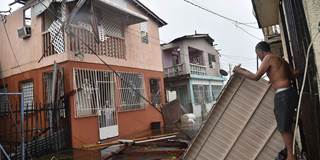After the humanitarian situation in Puerto Rico is stabilized, policymakers should focus on providing the island with reliable, cost-effective electric power, generated primarily by renewables and distributed over a smart, resilient grid. Ensuring energy availability will be indispensable for recovery and sustained economic growth.
WASHINGTON, DC – President Donald Trump and the US Congress are coming under mounting pressure to increase assistance to Puerto Rico. The devastation caused there last week by Hurricane Maria has only exacerbated severe longer-term problems resulting from deferred maintenance on the island’s critical infrastructure. Puerto Rico needs more than short-term assistance (although this is also urgent); it needs bipartisan support to rebuild, with an initial and essential focus on a more robust and cheaper supply of electricity.
The existing electricity grid has substantially collapsed, with the Federal Emergency Management Administration (FEMA) estimating that up to 90% of the transmission system may have been destroyed by the hurricane. A major dam is at risk. Damage to the air traffic control infrastructure has severely limited flights to and from the island. As Governor Ricardo Rosselló has stated publicly, there is now a real risk of a major humanitarian disaster. Donations are flowing in, but the total will be small relative to what is needed.
The Trump administration says that FEMA is working hard and effectively. Let’s hope they are right. There will be a lot of questions about whether Puerto Rico’s roughly 3.4 million US citizens receive the same support as Texas and Florida (and other parts of the 50 states) when natural disaster strikes. But the bigger question is this: What will be done – and by whom – to help Puerto Rico really recover?

WASHINGTON, DC – President Donald Trump and the US Congress are coming under mounting pressure to increase assistance to Puerto Rico. The devastation caused there last week by Hurricane Maria has only exacerbated severe longer-term problems resulting from deferred maintenance on the island’s critical infrastructure. Puerto Rico needs more than short-term assistance (although this is also urgent); it needs bipartisan support to rebuild, with an initial and essential focus on a more robust and cheaper supply of electricity.
The existing electricity grid has substantially collapsed, with the Federal Emergency Management Administration (FEMA) estimating that up to 90% of the transmission system may have been destroyed by the hurricane. A major dam is at risk. Damage to the air traffic control infrastructure has severely limited flights to and from the island. As Governor Ricardo Rosselló has stated publicly, there is now a real risk of a major humanitarian disaster. Donations are flowing in, but the total will be small relative to what is needed.
The Trump administration says that FEMA is working hard and effectively. Let’s hope they are right. There will be a lot of questions about whether Puerto Rico’s roughly 3.4 million US citizens receive the same support as Texas and Florida (and other parts of the 50 states) when natural disaster strikes. But the bigger question is this: What will be done – and by whom – to help Puerto Rico really recover?